With history buff family in town, we took a day trip this summer to visit two Hudson River mansions in Hyde Park, the Roosevelt mansion and the Vanderbilt Mansion. I’ll post separately.
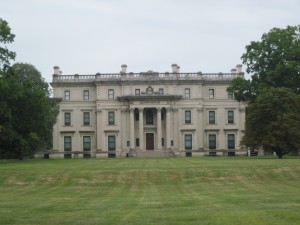
Admittedly I knew little about the Vanderbilts before we went, so the history was quite interesting. I can confirm I already knew about clothing designer Gloria Vanderbilt (I coveted her jeans in high school) and her very cute son Anderson Cooper. As for the rest of the family, I get lost in the family tree, especially since half of them seemed to be named Cornelius.
At one time, the Vanderbilt family had 12 mansions on 5th Avenue, but now there’s only Grand Central Terminal. If you haven’t been, you should go.
This mansion belonged to Frederick Vanderbilt, who I think was a grandson of the original Cornelius, who made the family wealth in railroads. I’ll call him Fred. He stayed here with his wife only a few months a year (April until the first hot day, and then September to November), spending the rest of the year at the Breakers, his larger mansion in Newport, Rhode Island and several other places too. He had 3-4 mansions in the yearly rotation (just like you, I know).
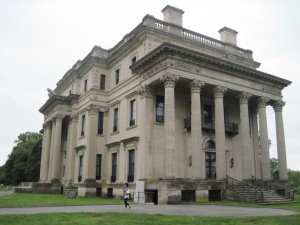
The mansion was built in 1895 on a 600 acre park (it’s now a little more than 200 acres). Originally it was a 40 room wooded mansion, owned by John Jacob Aster. Fred tore it down and replaced it with a 52 room masterpiece that took 26 months to build by hand with imported European tradesmen. The landscaping is the oldest owned by the National Park Service.
Vanderbilt was “new rich” – like the Rockefellers. They were not part of old-money society. This money came from railroads and shipping. At one time, The Vanderbilts owned 85% of all the operating railroads in the country – no antitrust laws then. They owned the union stations (think Western Union).
How to accumulate so much money? They didn’t have to pay corporate, federal, personal or inheritance taxes! Since the Civil War was over, federal taxes were too. During this Gilded Era, mansions proliferated (what else would they do with their millions?)
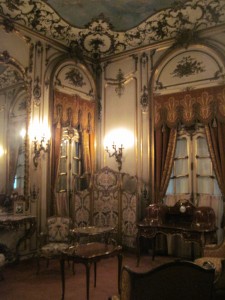
————————————————
[ad name=”Google Adsense”]
————————————————
Fred was the family’s first college graduate (Yale), and he and his first cousin/wife Louise had no kids. His father started the Metropolitan Opera. Fred started his career with $10 million, and built that up to $80 million, so he was no slouch.
Back to the house. When this mansion was built it cost $2.5 million total, including $1.5 million in FURNISHINGS. They had a one mile riverfront. In addition to the main mansion they built a 16 room guest house (now it houses the ticket desk and gift shop), which was constructed in 66 days, and used by Fred to watch over the mansion as it was built. He brought in 200 Italian immigrants plus German stone carvers. The woodworkers were Swiss. It took 26 months to build the mansion by hand, working 12 hour days, seven days a week. Workers lived on site.
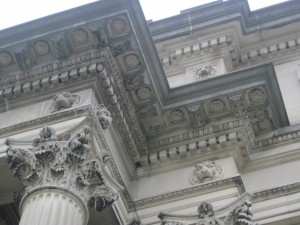
The mansion is European style, with the gardens away from the house – and there was also a farm. Inside you’ll see the fireplace made of Russian walnut. They typically had 100 vases with fresh flowers from the gardens. While the mansion looks plenty furnished, we were told there was only about 30% of the furnishings that was present during their time – it was much busier and more ornate.
They usually had guests there, and breakfast in bed was the norm. They’d ring the buzzer for breakfast, and the servants would send food up the dumb waiter, running up and down the stairs to bring the food. They had 10 sets of china – one per guest room.
Six flights of stairs were reserved for the servants so they wouldn’t be seen (nor will you see the third floor servant wings). Female servants were young, unmarried and Irish. The male servants lived in the basement – 60 servants in all worked there (and most lived there too). They worked 10 hour days, going up and down the stairs.
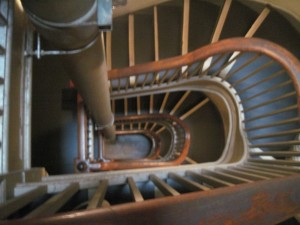
The attic had a 9,000 gallon water tank, to use in the 14 bathtubs. Coal was loaded into the house via a manhole so as not to appear unsightly. The wine cellar was in the basement, under the front steps. Four women did laundry all day long, using steam heat. The boiler ran all winter long, even though the Vanderbilts weren’t there – they did need staff to maintain the house. We got to see the ice box, which held 100 pound ice blocks in the basement. That’s where they also arranged flowers. The chef only cooked for the Vanderbilts and guests – the staff had their own cook.
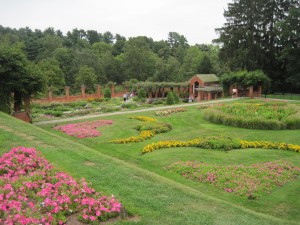
The house was for sale for two years, and neighbor FDR convinced the niece to donate the house to the National Park Service (FDR also donated his house, the first presidential house donated). It wasn’t selling and was tough to maintain.
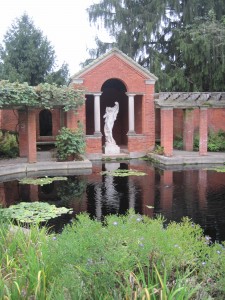
The Vanderbilts stressed outdoor entertainment, with tennis courts and a yacht. While visiting, the ladies changed clothes an astounding 10 times a day – it was a party all day. There was no entertainment within the house – everything was outdoors (not sure what they did when it rained). They kept six extra limousines available for guest use, since some guests arrived via boat. That seems extravagant, but at that time, 45% of American jobs were as domestic servants.
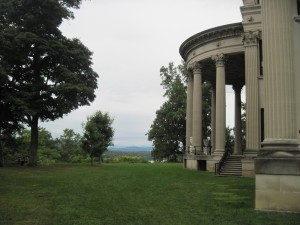
Tour: less than an hour long. You’ll see the basement, first and second floors, and use the main staircase and the servants’ staircase. You can also tour the gardens on your own.
Good for the Kids? They were a little bored during the tour, but did like looking at the house and walking around the gardens.
Tickets: You need timed tickets. Best to get them in advance – if space permits, you can switch tour times when you get there. We also got tickets for the Franklin Delano Roosevelt home nearby (extra cost) and presidential library. Post coming soon.
Cost: the grounds/parking are free. Tours are $8/person (free for ages 15 and under). They honor the senior passes.
Eats: Plenty of restaurants in Hyde Park (including the Culinary Academy of America). We went to the Eveready Diner, which was awesome to see. The food was fine, but the ambiance was great. Will do a separate post on that.
What’s your favorite road food????
This post is sponsored by #kiasocialclub. All content is mine, however.
Content and/or other value provided by our partner, Kia Motors


